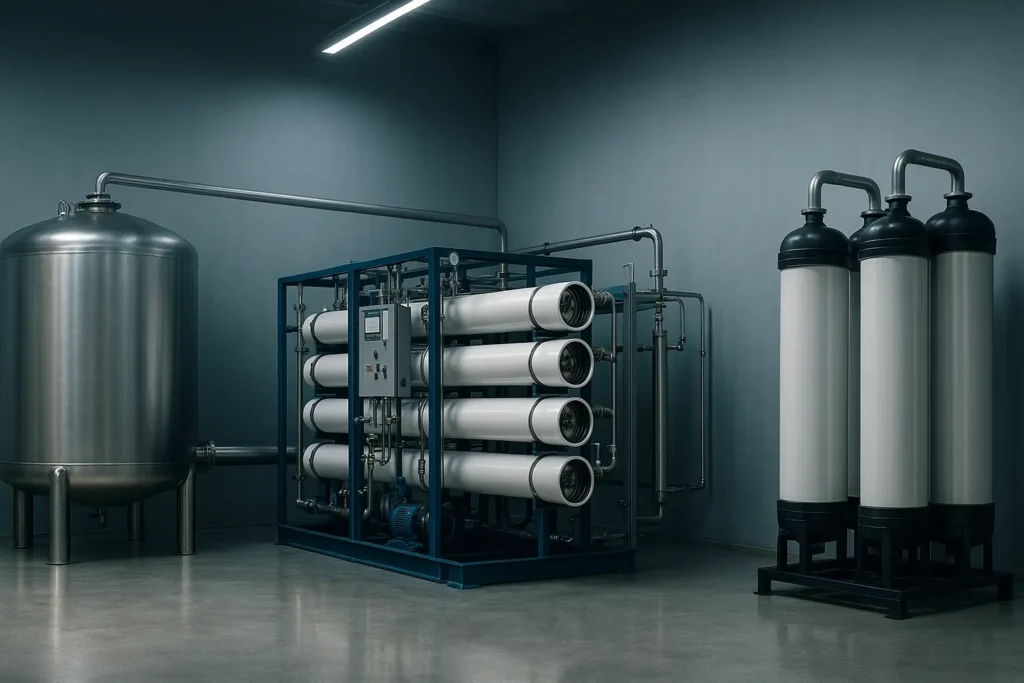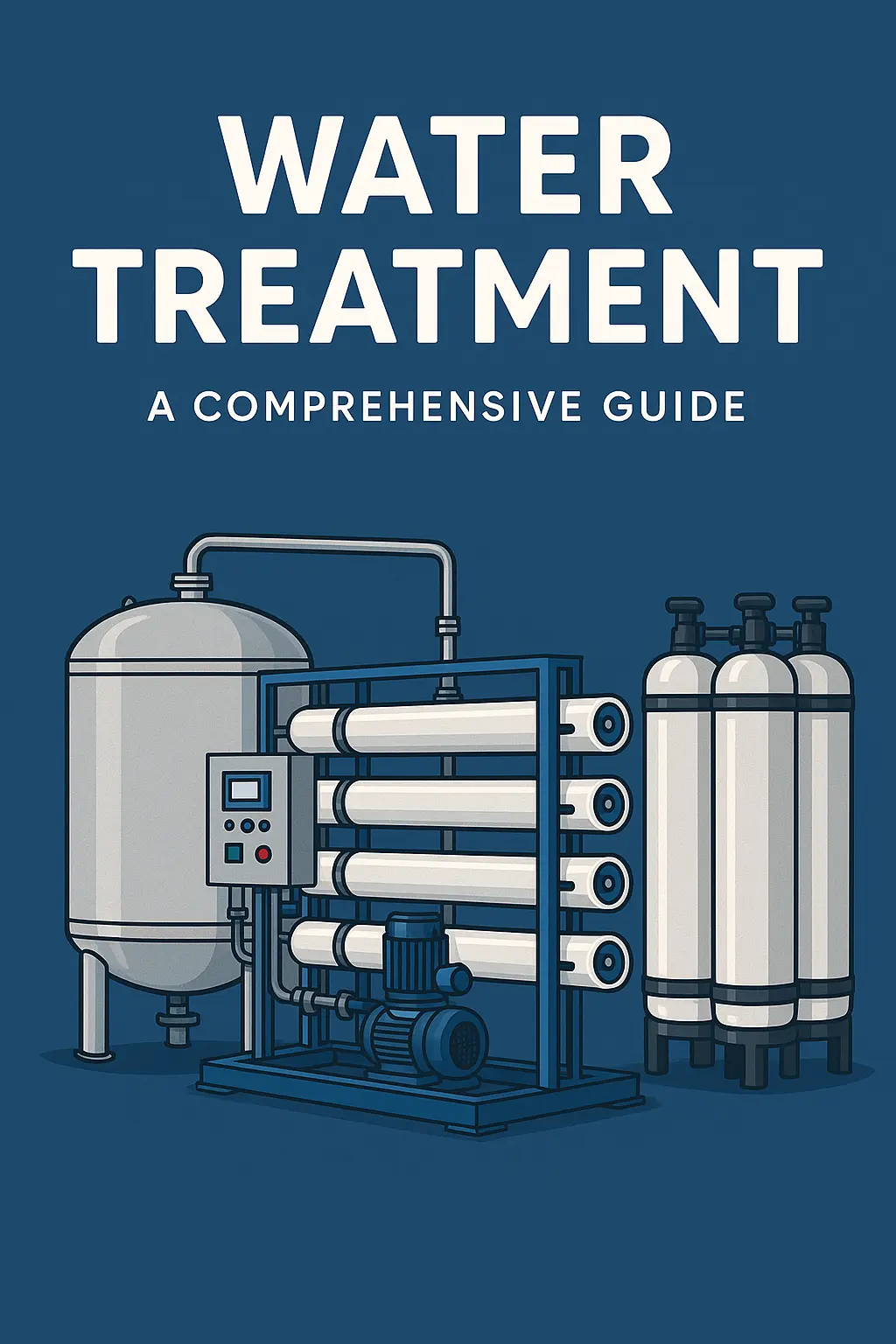This engineering overview clarifies pure water types and applications you’ll meet in B2B projects—ultrapure (DI/UPW), demineralized water for boilers, reuse water, well/groundwater treatment and domestic systems. For each, we outline typical process trains, indicative specs, selection notes and a purchasing checklist to help scope, compare and execute projects faster.
This guide to pure water types and applications summarizes where each type fits, the typical process trains, and what to check before design. If you are scoping a new plant or retrofit, start with the tables below and keep the process notes close to ensure stable, compliant operation.

1) Snapshot: pure water types and applications at a glance
| Typ | Typical uses | Go-to process train | Indicative targets* |
|---|---|---|---|
| Ultrapure water (DI / UPW) | Semiconductor, display, photovoltaic, precision optics, lab | UF (optional) → RO-1 → RO-2 → EDI or mixed bed → UV / 0.2 μm final filter; SS316L sanitary loop | Resistivity up to 18 MΩ·cm; tight microbial/TOC control (site acceptance required) |
| Demineralized water (boiler/service) | Power, chemical plants, general industry boiler make-up | MMF → Carbon → Softening or antiscalant → RO → (optional) MB/EDI → Storage & loop | Meets applicable boiler water standards/specs |
| Reuse / recycled water | PCB/electroplating, textiles, food & beverage, municipal reuse | MF/UF → RO (plus oxidation/precipitation as needed); metals recovery when relevant | To spec per process reuse requirements |
| Well / surface water | Iron/manganese removal, odor control, compliant supply | Air/oxidation → MMF → Carbon → Disinfection; RO added when low conductivity is needed | Meets drinking/process intake standards |
| Domestic treatment | Residential central filtration/softening/RO point-of-use | Carbon/UF → Softener → RO final stage | Better taste/hardness and safety |
*All targets are indicative; acceptance must rely on vendor documentation and on-site testing.
See the EPA drinking water overview for intake limits.
2) Ultrapure (DI/UPW): where quality margins are tightest
For chips, OLED, PV and precision optics, pure water types and applications at this level demand two-stage RO with EDI or mixed bed polishing, stainless-steel contact tanks and a sanitary distribution loop. Focus on bio-control (UV, 0.2 μm final filter), trending conductivity/TOC and setting normalized performance thresholds for CIP.
- Materials: SS316L (electropolished where needed) and hygienic plastics; vent filtration on tanks.
- Instrumentation: inline conductivity/temperature/flow/ΔP, TOC where required, data logging for audits.
Related products: stainless-steel tanks & contact vessels · RO membranes & housings, resin, carbon, dosing pumps, cartridges
3) Demineralized water: robust make-up for boilers and processes
Demin focuses on stable desalting plus hardness control. A conservative recovery RO, paired with softening or antiscalant, keeps scaling at bay. PLC/HMI automates start/stop, flushing and chemical dosing to maintain availability and compliance.
Typical train: MMF → Carbon → Softener/antiscalant → RO → (optional) MB/EDI → Storage & loop.
For boiler make-up quality, refer to IAPWS/ASME guidance.
4) Reuse water: balancing savings and reliability
In plating, textiles and F&B, reuse schemes often apply MF/UF → RO. Upstream segregation, realistic feed windows (COD/color/TDS/metals) and SDI control decide whether the membranes stay clean. When done well, pure water types and applications that reuse water can reduce both purchase and discharge costs.
- Track bio-growth and fouling indicators; add oxidation/precipitation where metals or dyes are present.
- Log chemical consumption and normalized KPIs to optimize OPEX.
5) Well/surface water: iron & manganese out, compliance in
Typical issues are Fe/Mn, H2S odor, turbidity and microbes. Air/chemical oxidation with catalytic media, followed by MMF and carbon, solves most cases; add RO only if your downstream specification requires low conductivity.
6) Domestic treatment: who does what in the stack
Central filtration/UF removes chlorine and taste; softening drops hardness; a compact RO provides final desalting at the point of use. Cartridges and resin are replaced per pressure drop/quality trends.
7) Selection notes for engineers
- Feed characterization: turbidity/SDI, hardness, residual chlorine/organics, metals and microbes determine pretreatment and membrane choice.
- Recovery vs. scaling: bias to stability; use softening/antiscalant; consider 2-stage RO for tight specs.
- Materials & hygiene: UPVC/PP upstream; SS316L and sanitary plastics downstream. Control ventilation of tanks and loop velocity for bio-risk.
- Monitoring: normalize flow/ΔP/conductivity; define CIP triggers and keep audit trails.
These rules keep projects using pure water types and applications predictable across seasons and shifts while controlling OPEX.
8) Purchasing checklist (BOM) + CTA
- Pretreatment: multimedia, carbon, softening or antiscalant, 5 μm cartridge filters
- Core purification: RO high-pressure pump, vessels/elements, flow/pressure/temperature instruments, PLC/HMI
- Polishing (as needed): EDI or mixed bed, carbon polishing, UV, 0.2 μm final filter
- Storage & distribution: stainless-steel storage/contact tanks, recirculation pump, inline conductivity/TOC (as specified)
- Accessories & consumables: membranes & housings, dosing pumps, carbon, resin, filter cartridges
9) FAQs
How do pure water types and applications differ between DI/UPW and demin water?
UPW focuses on ultra-low ions, organics and microbes (2-stage RO + EDI/MB + sanitary loop). Demin targets boiler/process make-up where stable desalting and hardness control matter most.
When is RO mandatory for well water?
Use RO when downstream specifications require low conductivity or specific ion removal. For compliant supply only, oxidation + filtration + disinfection is often sufficient.
Does reuse always save cost?
Only if feeds are segregated and pretreatment keeps SDI low. Correctly run, reuse reduces purchase and discharge fees and can offset chemical/energy costs.
Stark Water Engineering Team — RO/EDI/MB system design, retrofits and commissioning
10) Summary
In short, choosing the right train for pure water types and applications comes down to feed stability, target specs and lifecycle cost. When in doubt, specify robust pretreatment, conservative RO recovery, and the polishing method that matches your compliance window. For teams comparing options for pure water types and applications, our engineers can share reference P&IDs and BOMs on request.

